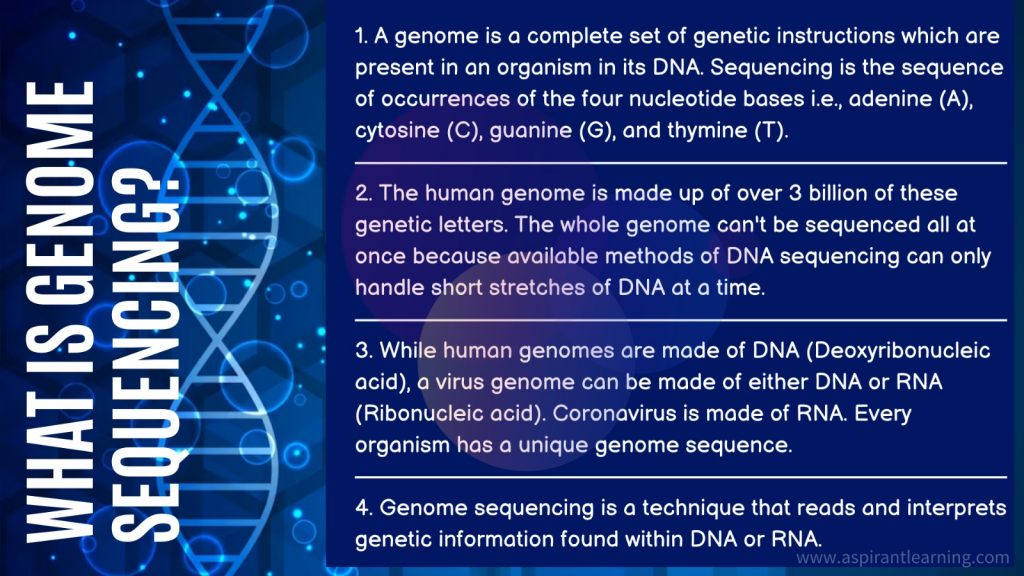News Highlights:
- The Ministry of Science and Technology aims to sequence 10,000 genomes by the end of the year 2023 under the Genome India Project (GIP).
- According to the Secretary of the Department of Biotechnology (DBT), the Ministry of Science and Technology has sequenced close to 7,000 genomes, and 3,000 of these are already available for public access.

Genome India Project:
- About:
- The Genome India Project, a collaboration of 20 institutions, including the Indian Institute of Science and some IITs, will enable new efficiencies in medicine, agriculture and the life sciences.
- It aims to ultimately build a grid of the Indian “reference genome”, to fully understand the type and nature of diseases and traits that comprise the diverse Indian population.
- The mega project hopes to form a grid after collecting 10,000 samples in the first phase from across India to arrive at a representative Indian genome.
- Background:
- It is a scientific initiative inspired by the Human Genome Project (HGP), an international effort that successfully decoded the entire human genome between 1990 and 2003.
- The project was started in 2020, aiming to understand better the genetic variations and disease-causing mutations specific to the Indian population, which is one of the most genetically diverse in the world.
- Importance:
- By sequencing and analysing these genomes, researchers hope to gain insights into the underlying genetic causes of diseases and develop more effective personalised therapies.
Need for Genome India Project:
- Diverse population:
- India’s population of 1.3 billion is made up of over 4,600 diverse population groups, many of which are endogamous (Matrimony in Close Ethnic Groups).
- These groups have unique genetic variations and disease-causing mutations that cannot be compared to other populations.
- Personalise drugs and therapies:
- By creating a database of Indian genomes, researchers can learn about these unique genetic variants and use the information to develop personalised drugs and therapies.
- Success in other countries:
- The United Kingdom, China, and the United States are among the countries that have programmes to sequence at least 1,00,000 of their genomes.
Intended Benefits of GIP:
- Precision Healthcare:
- GIP will help develop personalised medicine, anticipating diseases and modulating treatment according to the genome of patients.
- For example, cardiovascular disease generally leads to heart attacks in South Asians but to strokes in most parts of Africa.
- If such propensities to disease can be mapped to variations across genomes, it is believed that public health interventions can be targeted better, and diseases anticipated before they develop.
- Sustainable Agriculture:
- Similar benefits would come to agriculture if there is a better understanding of the genetic basis of the susceptibility of plants to pests, insects and other issues hampering productivity.
- This can reduce dependence on chemicals.
- International Cooperation:
- Global science would also benefit from a mapping project in one of the world’s most diverse gene pools.
- The project is said to be among the most significant of its kind in the world because of its scale and the diversity it would bring to genetic studies.
Issues Concerning:
- Genetic inequality:
- Genetic bias in medical insurance, jobs, and other areas is probable.
- It might give a biological perspective on topics like indigenous culture, religion or ethnicity issues, and ancestry identification.
- Changes in physical characteristics from genome editing:
- Although genetic engineering can heal various ailments, moral issues exist about the degree to which it may be used.
- There is a danger of premature genetic augmentation.
- Privacy:
- Permission from study participants, use of results, and related dangers all pose confidentiality concerns.
- There are technical and scientific hurdles to properly comprehending the possible advantages and hazards of gene sequencing.
- The issue of data handling and storage must be considered in light of the danger of data misuse.
- Unequal access:
- Restricted availability of genetic analysis and preventative treatment may exacerbate existing inequalities and cause social conflicts.
Pic Courtesy: Freepik
Content Source: The Hindu



